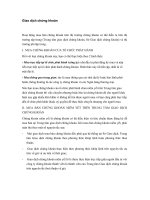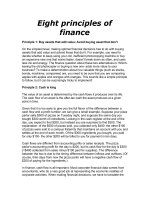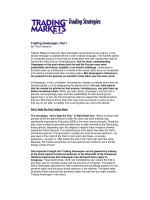Tài liệu THEME: ACCOUNTING FOR INVENTORY pdf
Bạn đang xem bản rút gọn của tài liệu. Xem và tải ngay bản đầy đủ của tài liệu tại đây (42.56 KB, 7 trang )
Copyright © 2008 John W. Day 1
THEME: ACCOUNTING FOR INVENTORY
By John W. Day, MBA
ACCOUNTING TERM: Inventory
Inventory can be defined as goods being held for resale. In manufacturing,
inventory can be raw materials, work-in-process, and finished goods.
FEATURE ARTICLE: Understanding Inventory Accounting
Occasionally I do live seminars on the basics of accounting and have found that
many participants had difficulty in understanding how accounting for inventory
works.
Let’s be clear, working with inventory can be complex depending on the type and
size of business. However, the basic concepts of inventory are not hard to grasp
and you really should have some familiarity with them. For those who already
work with and understand inventory, please bear with me as I lay out the
fundamentals. Also, this newsletter is a little longer and more technical than
usual, so you may want to take your time reading it.
You may recall from my August newsletter, issue #64, titled Cost of Goods Sold,
the inventory formula:
Beginning Inventory $XXX.XX
Add purchases during the month + XXX.XX
Subtract ending Inventory - XXX.XX
Cost of Goods Sold $XXX.XX
The first step is to conceptualize the “inventory process”. In other words, think
about what is going on. For example, suppose your company is in business to
sell a product. The product is acquired either by manufacturing it or purchasing it
as a finished product. During an accounting period, such as one month, all, or a
portion of the inventory is sold. Hopefully, the cost of the product did not exceed
its sale price so that a profit was realized. With the money from the profit, more
inventory can be purchased to sell, cover overhead expenses, and pay yourself.
The challenge is to determine, as accurately as possible, your Cost of Goods
Sold (COGS). There are various ways to do this depending on whether a
“periodic” or “perpetual” system of recording inventory is used. In case you are
unfamiliar with these terms, let’s review them:
Copyright © 2008 John W. Day 2
Periodic
Periodic inventory accounting involves an increase (debit) to Purchases when
acquisitions are made. Remember, “Purchases” is a general ledger (GL)
account found in the cost of sales section of the Profit & Loss Statement. At the
close of the period, a physical count of the remaining inventory is required to
determine the amount unsold. The quantity is then priced and recorded in order
to determine the COGS. (See formula above and/or The Journal Entry August
issue #64)
Here is a quick example, using T-Accounts:
(a)Beginning inventory was $3,000
(b)Purchased new inventory of $1,000
(c)Counted remaining inventory of $2,500
(d)Adjusted Purchases and Inventory to reflect actual ending Inventory
Cash Inventory Purchases
| 1,000 (b) (a) 3,000 | 500 (d) (b) 1,000 |
2,500 (d) 500
1,500
Perpetual
As acquisitions of new inventory are made, they are charged (debited) to the
Inventory account. Each time a sale is made a corresponding entry is made
removing (crediting) the item from Inventory and charging (debiting) COGS (or
Purchases). The result is that the Inventory account maintains a current balance,
and the COGS account reflects the cost of goods sold to date. One of the
benefits of using a perpetual inventory system is that you can run interim
financial statements without the necessity of a physical inventory count. In
addition, shortages and any other discrepancies may be discovered and
corrective action taken.
One way to remember the difference between the two methods is that the
periodic system discloses what is on hand, whereas, the perpetual system
discloses what should be on hand.
Once the inventory system you are going to use has been selected, the method
by which to price the inventory has to be selected. You may have heard of some
of these methods, i.e., FIFO (First-in, First-out); LIFO (Last-in, First-out);
Weighted Average; Specific Identification; and Retail Method. Here is a brief
overview of each:
Copyright © 2008 John W. Day 3
Conventional Inventory Pricing Methods
FIFO
First-in, first-out (Last-in, Still-here) implies that the items that were purchased
first will be sold first. Cost of goods sold is calculated by using the oldest prices,
and ending inventory is calculated based on the most recent prices. Using this
method tends to result in a fair statement of inventory on the Balance Sheet.
This is because the ending inventory was purchased most recently. Further,
when inventory turns over regularly, the prices used for the cost of goods sold
are somewhat current resulting in fair presentation of the cost of sales amount.
LIFO
Last-in, first-out (First-in, Still-here) implies that the items most recently acquired
will be the first sold. Cost of goods sold is calculated by using recent prices,
while ending inventory is calculated using the oldest prices. This method tends
to emphasize the matching concept accounting principle by matching current
costs with current sales on the Profit and Loss Statement. Eventually however,
the inventory prices used for balance sheet purposes may become outdated and
unrealistic. This is because current prices may rise or fall causing the true value
of the ending inventory to become under or overstated.
Weighted Average
This method involves assigning the same unit price to items in Inventory and to
items in COGS. The price assigned is the average price for the period calculated
by taking the total cost of beginning inventory plus the cost of all units purchased
during the period and dividing the total by the number of units involved. For
instance:
Using Periodic:
100 units purchased @ $1.00 on Jan 1 = $100
150 units purchased @ $2.00 on Jan 14 = $300
130 units purchased @ $2.50 on Jan 26 = $325
380 Cost per unit ($725/380) = $1.908 $725
Cost of Goods Sold
140 (380 – 240) @ $1.908 $267
Ending Inventory
240 @ $1.908 $458
Total Units Reconciled $725
Copyright © 2008 John W. Day 4
Using Perpetual:
January
1 - Balance 100 units @ $1.00 $100
14 - Purchased 150 units @ $2.00 $300
Balance 250 units @ $1.60 ($400/250) $400
19 - Sold 140 units @ $1.60 Cost of Goods Sold $224
Balance 110 units @ $1.60 $176
26 - Purchased 130 units @ $2.50 $325
Balance 240 units @ $2.09 ($501/240)
Ending Inventory $501
Summary:
Cost of Goods Sold $224
Ending Inventory $501
Total Units Reconciled $725
Notice that, in this particular case, the COGS using the periodic system is higher
($267) than the perpetual system ($224). Translating the outcome further, you
can see that Gross Profit will be higher using the perpetual system because
COGS is lower. For example:
Periodic System Perpetual System
Sales $1000 $1000
Cost of Goods Sold -267 -224
Gross Profit $ 733 $ 776
Suffice it to say that using a FIFO method, the outcome is the same when using
either the periodic or perpetual system. LIFO is a different story because the
outcome varies when using either the periodic or perpetual system. FIFO and
LIFO will produce different results in calculating the value of the closing
inventory. In times of inflation when prices are rising, LIFO will produce a larger
COGS and a lower closing inventory. In time of falling prices, FIFO will produce
the larger COGS.
Specific Identification
This method is used to identify the cost of each inventoried item by matching the
item with its cost of acquisition in addition to other allocable costs, such as labor
and transportation. Although this method tends to be more accurate than the
other methods, it requires a sophisticated software program for inventories that
have large quantities of small items.
Copyright © 2008 John W. Day 5
Retail Method
This is a method used for estimating COGS and ending inventory. The value of
ending inventory is determined by applying an average markup percentage to the
total retail price of goods on hand. I have provided a brief description of this
method in the August issue (#64) of The Journal Entry. Next month’s newsletter
will discuss the Retail Method more in depth.
The main point of this discussion is that fundamental accounting for the inventory
process is straightforward once you have established values for Beginning
Inventory, Purchases, and Ending Inventory. With those values you can deduce
(squeeze) what the value is for COGS. In addition, you can begin to see that
there is a lot more to valuing inventory than first meets the eye. Using a
particular inventory valuation system can achieve various outcomes so make
sure to use the one that most helps your business. Due to the complexities
involved, you would be well advised to seek an opinion from your accountant.
QUESTION: How Does Manufacturing Inventory Accounting Work?
Managing a manufacturing inventory system can become quite complex, even for
the very small business. The following provides a general idea of how it works:
First, think about the process in terms of “stages”. For example, raw materials
(Stage 1) are used to create a product. When the raw materials are used to start
the construction of the product, but are not yet finished (Stage 2), the product is
said to be “in progress”. Once the product is finished (Stage 3), then, of course,
the product is ready to sell. When the product is sold (Stage 4), the product cost
has to be taken out of Inventory and recorded as a COGS.
Manufacturing companies usually follow a format similar to this:
Raw Materials:
Beginning raw materials inventory $10,000
Add purchases 5,000
Subtract ending raw materials inventory <7,000>
Work-in-process $ 8,000
Work-in-Process:
Beginning work-in-process $ 6,000
Add new goods from raw materials 8,000
Add labor, overhead burden, supplies 4,000
Subtract ending work-in-process <9,000>
Finished Goods $ 9,000
Copyright © 2008 John W. Day 6
Finished Goods:
Beginning finished goods $15,000
Add new finished goods from work-in-process 9,000
Subtract ending finished goods <7,000>
Cost of Goods Sold $17,000
The most difficult part of this process is determining the cost of raw materials,
labor, overhead, and other supplies, etc., that go into each finished good.
Establishing these costs accurately is critical, because you must price your
finished goods to ensure that a profit will be made, while at the same time stay
competitive with other similar industry manufacturers.
One of the pitfalls for the entrepreneur, who single-handedly tries to start his/her
own small manufacturing concern, is wearing too many hats. If you are the
person with the knowledge of how to create fashionable bicycle wear garments;
the seamstress; the sales clerk; the sales representative; the marketing
executive; the bookkeeper; the buyer; etc., you will soon wear yourself out and
fail. Enter this arena with great caution, otherwise you may find yourself holding
onto the tiger’s tail and unable to let go.
TIP: Using Accrual Or Cash Basis For Inventory.
Formerly, at least in the U.S., if your business carried inventory, it automatically
meant you were on an accrual method of accounting. Times have changed and
now the Internal Revenue Service (IRS) allows those of us with average annual
gross receipts of $1 million or less to use the cash method of accounting. (Rev.
Proc. 2001-10) Average annual gross receipts are computed for the three-year
period prior to the year to which the test applies.
Why does this matter to anybody? Let’s say you are a little guy struggling to
keep your business alive. If you are forced to use an accrual method for tax
purposes, the impact on your cash position might be devastating. When using
an accrual method, all sales are counted as revenue whether payment has been
collected or not. Taxes are paid on the net profit of your business, regardless of
collections. Result: Big tax bill, no money to pay.
Under the cash basis method, you are required to report as income only the cash
received from sales. Additionally, only those purchases that have been paid for
can be deducted. However, if you recorded all cash purchases of inventory as
COGS even though they had not been sold, there will be little correlation between
sales and cost of sales. For this reason, the IRS ruling requires those
businesses that qualify for the “less than $1 million in gross receipts rule” to only
count as expense (deduct) inventories that have been paid for, or actually used,
whichever is later.
Copyright © 2008 John W. Day 7
What this means is that you do not have to use a full accrual system if you carry
inventory, but inventory that has not been sold cannot be counted as a COGS.
Therefore, it must be counted as an inventory asset on the balance sheet. In
addition, inventory purchased through Accounts Payable cannot be recorded as
a COGS, or an inventory asset, because it has not been paid for or sold.
If you are an accrual basis taxpayer and want to change your accounting method
because you qualify for the “less than $1 million gross receipts rule” you can get
automatic approval from the IRS by filing Form 3115. Be aware, though, that
shifting from accrual to cash can have certain tax consequences because you
have to make up the difference in income and expenses that occur from
changing accounting methods. Completing this form can become an ordeal.
The real significance of this IRS ruling is that the small business taxpayer who, in
the past, was carrying inventory and using a cash basis method of accounting is
now in compliance with the law. Please keep in mind that my intention here is to
offer a “heads up” in case you are unfamiliar with these issues, not to give any
specific tax advice. For that, be sure to check with your tax advisor.
John W. Day, MBA is the author of two courses in accounting basics: Real Life Accounting for Non-
Accountants (20-hr online) and The HEART of Accounting (4-hr PDF). Visit his website at
to download his FREE e-book pertaining to small business accounting
and his monthly newsletter on accounting issues. Ask John questions directly on his Accounting for Non-
Accountants blog.









